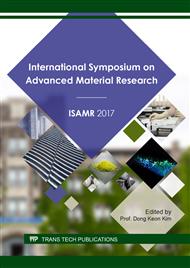[1]
American Welding Society (AWS), Welding Handbook, vol. 3 Part 2, 9th edition, 2007, PP 15-26.
Google Scholar
[2]
S. Aslanlar, A. Ogur, U. Ozsarac, E. Ilhan, Welding time effect on mechanical properties of automotive sheets in electrical resistance spot welding, Mater. Des. 29(7) (2008) 1427-1431.
DOI: 10.1016/j.matdes.2007.09.004
Google Scholar
[3]
N. T. Williams, J. D. Parker, Review of resistance spot welding of steel sheets Part 1 Modelling and control of weld nugget formation, Int. Mater. Rev. 49(2) (2004) 45-75.
DOI: 10.1179/095066004225010523
Google Scholar
[4]
T. Horiuchi, P. Reed. Richard, Austenitic steels at low temperatures, Springer Science & Business Media, (2012).
Google Scholar
[5]
D. Özyürek, An effect of weld current and weld atmosphere on the resistance spot weldability of 304L austenitic stainless steel, Mater. Des. 29(3) (2008) 597-603.
DOI: 10.1016/j.matdes.2007.03.008
Google Scholar
[6]
J. C. Ma, Y. S. Yang, W. H. Tong, Y. Fang, Y. Yu, Z. Q. Hu, Microstructural evolution in AISI 304 stainless steel during directional solidification and subsequent solid-state transformation, Mater. Sci. Eng. A 444(1) (2007) 64-68.
DOI: 10.1016/j.msea.2006.08.039
Google Scholar
[7]
N. Suutala, T. Takalo, T. Moisio, Ferritic-austenitic solidification mode in austenitic stainless steel welds, Metallurgical Trans. A 11(5) (1980) 717-725.
DOI: 10.1007/bf02661201
Google Scholar
[8]
S. J. Fukumoto, K. N. Fujiwara, T. J. Shin, Atsushi Yamamoto, Small-scale resistance spot welding of austenitic stainless steels, Mater. Sci. Eng. A 492(1) (2008) 243-249.
DOI: 10.1016/j.msea.2008.05.002
Google Scholar
[9]
J. B. Shamsul, M. M. Hisyam, Study of spot welding of austenitic stainless steel type 304, J. Appl. Sci. Res. 3(11) (2007) 1494-1499.
Google Scholar
[10]
Karcı, Feramuz, Ramazan Kacar, Süleyman Gündüz, The effect of process parameter on the properties of spot welded cold deformed AISI304 grade austenitic stainless steel, J. Mater. Process. Technol. 209(8) (2009) 4011-4019.
DOI: 10.1016/j.jmatprotec.2008.09.030
Google Scholar
[11]
R. K. Okagawa, R. D. Dixon, D. L. Olson, The influence of nitrogen from welding on stainless steel weld metal microstructures, Weld. J. 62(8) (1983) 204s-209s.
Google Scholar
[12]
J. A. Brooks, A. W. Thompson, Microstructural development and solidification cracking susceptibility of austenitic stainless steel welds, Int. Mater. Rev. 36(1) (1991) 16-44.
DOI: 10.1179/imr.1991.36.1.16
Google Scholar
[13]
M. Pouranvari, M. Alizadeh-Sh, S. P. H. Marashi, Welding metallurgy of stainless steels during resistance spot welding Part I: fusion zone, Sci. Technol. Weld. Join. 20(6) (2015) 502-511.
DOI: 10.1179/1362171815y.0000000015
Google Scholar


